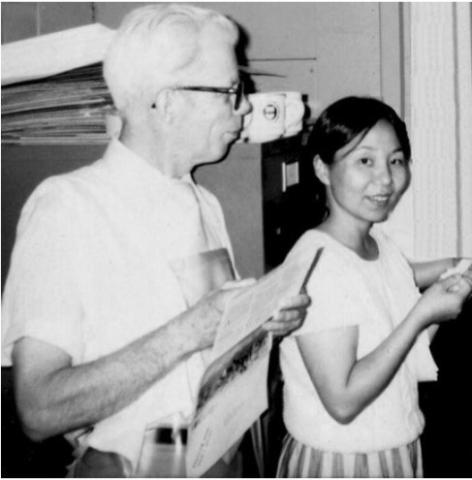Quest To Uncover Molecule’s Secret
NIDCR’s Park Retires After 42 Years at NIH

Dr. Myung Hee Park, a senior investigator in NIDCR’s molecular and cellular biochemistry section, was clearing out her lab ahead of her retirement when she found a notebook from the 1980s. On the lines of the yellowed pages lay the beginnings of her unexpected journey unraveling a previously unknown biological pathway vital to nearly all life on Earth. Her work opened a new field of research, and 42 years later, is revealing important clues about certain neurodevelopmental disorders.
“Nobody knew about this pathway—we stumbled on it by accident,” says Park, who retired June 30 after four decades of service at NIDCR. “This is often how progress is made in science—you cannot plan on discovering certain things.”
Such was the case in 1979, when, as a visiting fellow, Park joined the Laboratory of Biochemistry at the National Institute of Dental Research, NIDCR’s predecessor. She was tasked initially with studying the activity of an enzyme called transglutaminase, which is involved in wound healing, blood clotting and hair formation. But a serendipitous discovery led her down a new path.
In an experiment to pinpoint proteins modified by transglutaminase, one candidate containing an as-yet unidentified molecule showed up. Further analysis suggested that, contrary to the team’s hypothesis, this protein candidate was not actually modified via transglutaminase reactions, but by some other reaction.
Park relayed her suspicions to her mentor, NIDR biochemist Dr. John Folk. “He asked me, ‘If it is not a transglutaminase reaction, then what is it? You figure it out,’” recalls Park.
Within a couple of months, Park answered that question when she discovered the reaction that formed the mysterious molecule, which she identified as hypusine, an unusual and little-studied amino acid.
Unlike most other amino acids, hypusine is found in only one protein, which Park and collaborators later identified as eukaryotic translation initiation factor 5A (eIF5A). Park’s experiments showed that hypusine is formed in the eIF5A protein via a series of reactions catalyzed by enzymes in the so-called hypusine modification pathway.
In contrast to most other enzyme modifications, which often occur in many different types of proteins, the hypusine modification process acts only on eIF5A. Without it, the protein does not become activated to carry out its function.
“The cell devised this complicated pathway to modify a single protein,” says Park. “From the very beginning, we knew this had to be a vital process in the cells. Otherwise, it’s not economical for the body to develop these complex mechanisms.”
From then on, Park made it her mission to understand the pathway and its biological significance. She spent her career characterizing each step, identifying the proteins and enzymes involved and defining their functions in cell growth and animal development.

Park’s research showed that eIF5A indeed plays a crucial role in cells by regulating protein production, cell growth and tumor formation. Mice and yeast cannot survive without the eIF5A protein or the enzymes that help activate it. People with impaired eIF5A or hypusine modification enzymes exhibit developmental delays, intellectual disabilities, seizures and mild abnormalities in facial features, according to a recent study by Park and her collaborators at Columbia University.
“From the very basic science discovery of the hypusine pathway to now understanding its connection to human health, it feels like a full circle,” Park says.
She’s now working to publish her team’s research on new animal models they developed. The mice, which are engineered to express low levels of hypusine modification enzymes or eIF5A in the brain, display learning, memory and cognitive impairments. The animal traits reflect characteristics of patients with neurodevelopmental disorders linked to the hypusine pathway.
The animal models that Park leaves behind could help scientists find and test potential therapeutic compounds for these disorders. Her lifelong research findings could also serve as a foundation for studies to develop cancer interventions. Based on the pathway’s important role in tumor formation, reducing its activity could curtail the growth of cancer cells.
While pioneering science at the lab bench, Park also has been a leading figure among the Asian American and Pacific Islanders communities and women scientists at NIH. She served as president of the NIH Korean Scientists Association and the NIH chapter of the Korean-American Women in Science and Engineering group, providing opportunities for collaboration and guidance in career development to a new generation of scientists.
“Science is exciting and being a scientist is a 24-7 calling,” says Park. “It’s always in my brain and I even dream about it.”
While she welcomes the change of pace retirement brings, Park is not walking away entirely. She will serve as a special volunteer at NIH, following the latest scientific developments and providing her expertise to collaborators.
“Because of NIH’s support, I was able to blossom as a scientist and carry out my ideas,” Park concludes. “NIH is probably the best place in the world for scientists to get training, if they’re willing to work hard.”
